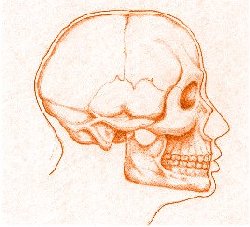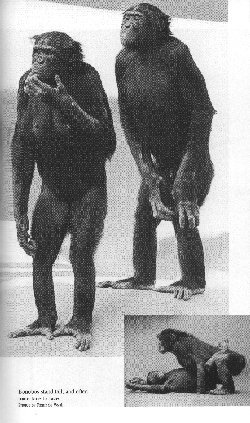| The appearance of hominids (Australopithecines etc.), about 4 - 3 million years ago coincides with the first glaciations occuring in the Northern Hemisphere. Could our ancestors have been forced to rely on the aquatic environment to supplement the dwindling food supplies on land? Could tool use have grown out of the need to break apart not only nuts, but also mollusks? The global radiation of Homo coincides with a later glaciation at about 1.8 million years. In between there was a warming trend and a rise in sea level (Chandler, M). This could have provided isolation of a species of hominid on islands and archipelagos. There, with different stresses, he may have gained a great "edge" over his competition in the hominid world. Reunion with their parental line would occur when the waters receded (LaLumierre 1981). |
 Homo sapiens |
| At the same time as Homo first appears on the scene (2 -1.8 Ma), the Australopithecines were still around, and experiencing their own "adaptive radiation". Again we are asking what was different in the evolution of Homo to that of Australopithecines and modern apes? (See Paleoenvironments and Prominent Fossil Finds) | |

Photos by Franz de Waal, courtesy Elaine Morgan
It is interesting that while no more genetically |
There is also the school of thought which states that the Australopithecines (like Lucy), are
not our ancestor at all. Some argue that it is more likely an ancestor of the chimpanzee, or
a side branch with no extant (living) decendents (Verhaegen 1994). Although clearly bipedal,
there is no reason
to discount that other primates may have also waded more than they do now, and adapted to
part-time bipedal locomotion, only losing it as conditions changed. The time lengths and degree
of these wading/walking intervals would govern how radical the
morphological changes would be in each species. In this line of reasoning, those
primates which led to gorillas and chimps, would have not acquired to the same degree the
semi-aquatic characters seen in those primates leading to Homo. This makes sense if we
accept that the forebearers of gorillas and chimps opted for the inland tree/land interface (dry),
while our ancestors remained at the interface of all three: land/water/trees.
A move inland would result in the lessening
of any "semi-aquatic"
features,
until they became simply vestiges of a past behaviour. It could have also led to increased
specialization. Specialization among the other hominid lines, in these limited drier environments, would demand different changes. Since Homo sapiens are generalists (Morgan 1997), our ancestors must have been the species, given changing climates and conditions, that utilized food resources the best. Nature dictates - he who can adapt most easily, usually wins out when things go bad. This may partly explain what happened to some of the other hominid species. They may have been over-specialized, thus were more vunerable to changing climatic conditions (Wilson 1991). |
Back to Contents
Back